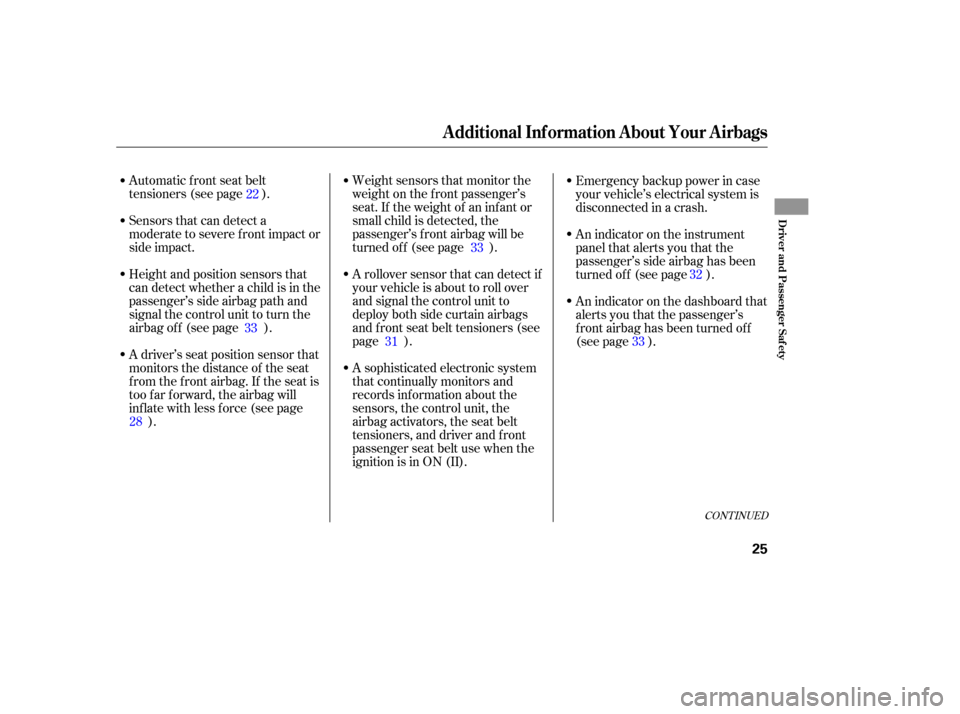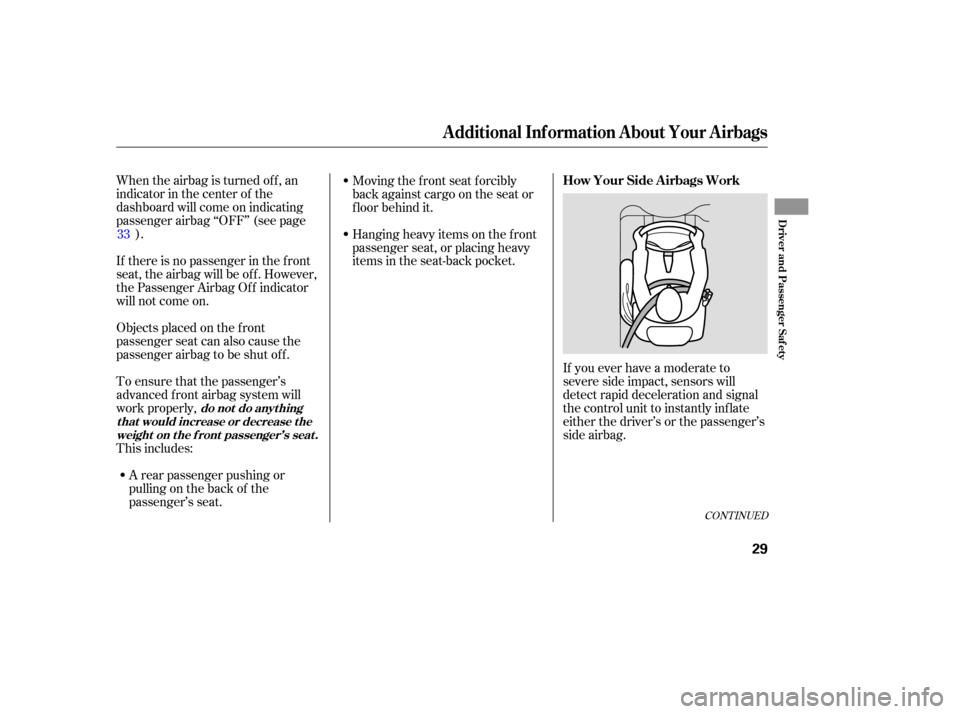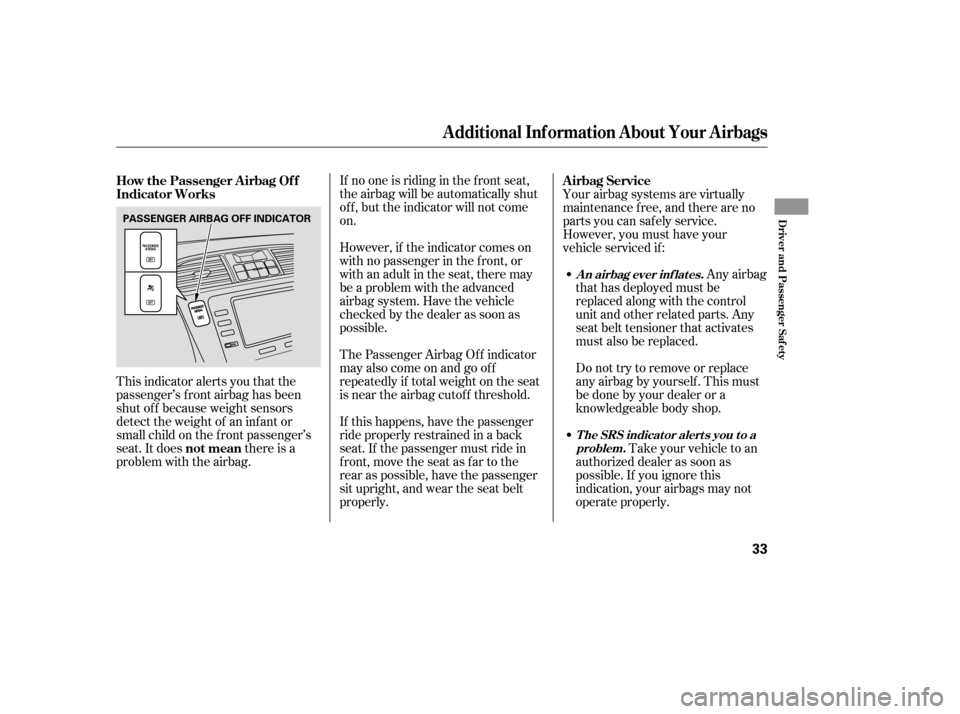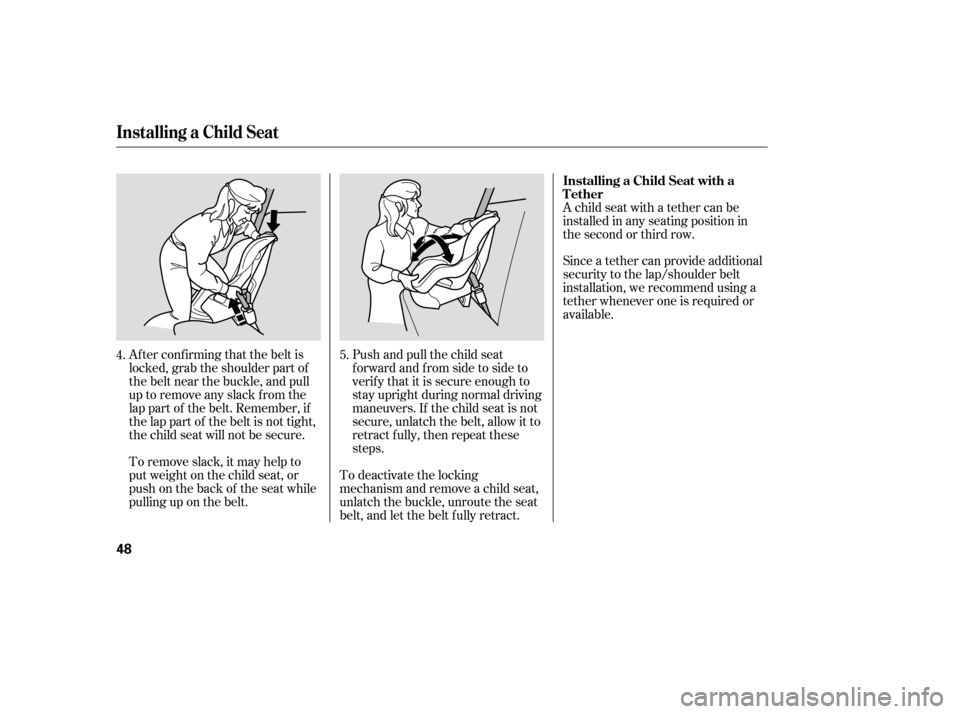weight Acura MDX 2005 Owner's Manual
[x] Cancel search | Manufacturer: ACURA, Model Year: 2005, Model line: MDX, Model: Acura MDX 2005Pages: 312, PDF Size: 4.1 MB
Page 26 of 312

Your Airbag System (SRS) includes:Two SRS (Supplemental Restraint
System) f ront airbags. The driver’s
airbag is stored in the center of
the steering wheel; the f ront
passenger’sairbagisstoredinthe
dashboard. Both are marked ‘‘SRS
AIRBAG’’ (see page ).
Two side curtain airbags, one f or
each side of the vehicle. The
airbags are stored in the f ront and
rear pillars and above the windows.
The f ront and rear pillars on both
sides are marked ‘‘SIDE
CURTAIN AIRBAG’’ (see page ).
Two side airbags, one f or the
driver and one f or a f ront
passenger. The airbags are stored
in the outer edges of the seat-
backs. Both are marked ‘‘SIDE
AIRBAG’’ (see page ).
26
29
31
Additional Inf ormation About Your Airbags
A irbag System Components
24
(5) (3)
(4)
(4)
(5)(2)
(10) (8) (10)(8)(9)
(11)
(7)
(9)(1)
(6)
(1) Driver’s Front Airbag
(2) Passenger’s Front Airbag
(3) Control Unit
(4) Seat Belt Tensioners
(5) Side Airbags
(6) Side Curtain Airbags
(7) Driver’s Seat Position Sensor
(8) Front Passenger’s Seat Weight Sensors
(9) Front Impact Sensor
(10) Side Impact Sensors
(11) Passenger Airbag Off Indicator
Page 27 of 312

CONT INUED
Automatic front seat belt
tensioners (see page ).Weight sensors that monitor the
weight on the f ront passenger’s
seat. If the weight of an inf ant or
small child is detected, the
passenger’s f ront airbag will be
turned of f (see page ).
Sensors that can detect a
moderate to severe front impact or
side impact.
Height and position sensors that
can detect whether a child is in the
passenger’s side airbag path and
signal the control unit to turn the
airbag off (see page ).
A driver’s seat position sensor that
monitors the distance of the seat
from the front airbag. If the seat is
too f ar f orward, the airbag will
inf late with less f orce (see page
). A rollover sensor that can detect if
your vehicle is about to roll over
and signal the control unit to
deploy both side curtain airbags
and f ront seat belt tensioners (see
page ).
A sophisticated electronic system
that continually monitors and
records inf ormation about the
sensors, the control unit, the
airbag activators, the seat belt
tensioners, and driver and f ront
passenger seat belt use when the
ignition is in ON (II). Emergency backup power in case
your vehicle’s electrical system is
disconnected in a crash.
An indicator on the instrument
panel that alerts you that the
passenger’s side airbag has been
turned of f (see page ).
An indicator on the dashboard that
alerts you that the passenger’s
f ront airbag has been turned of f
(see page ).
22
33
28 33
3332
31
Additional Inf ormation About Your Airbags
Driver and Passenger Saf ety
25
Page 30 of 312

The passenger’s advanced f ront
airbag system has weight sensors
under the seat. Although Acura does
not encourage carrying an inf ant or
small child in f ront, if the sensors
detect the weight of an inf ant or
small child, the system will
automatically turn the passenger’s
front airbag off.
The driver’s advanced front airbag
system includes a seat position
sensor under the seat. If the seat is
positioned too f ar f orward, the
airbag will inf late with less f orce,
regardless of the severity of the
impact.
If there is a problem with the sensor,
the SRS indicator will come on, and
the airbag will inf late in the normal
manner regardless of the driver’s
seating position.
Your f ront airbags are also advanced
airbags. The main purpose of this
feature is to help prevent airbag-
caused injuries to short drivers and
children who ride in f ront.
For both advanced airbags to work
properly:
Occupants must sit upright and
wear their seat belts properly.
Do not spill any liquids on or
under the seats, cover the sensors,
or put any cargo or metal objects
under the f ront seats.
Back-seat passengers should not
put their f eet under the f ront seats.
Failure to f ollow these instructions
could damage the sensors or prevent
them f rom working properly.
Additional Inf ormation About Your Airbags
Advanced Airbags
28
DRIVER’S
SEAT
POSITION
SENSOR PASSENGER’S
SEAT WEIGHT
SENSOR
Page 31 of 312

When the airbag is turned of f , an
indicator in the center of the
dashboard will come on indicating
passenger airbag ‘‘OFF’’ (see page).
If there is no passenger in the f ront
seat, the airbag will be off. However,
the Passenger Airbag Of f indicator
will not come on.
Objects placed on the f ront
passenger seat can also cause the
passenger airbag to be shut of f .
To ensure that the passenger’s
advanced front airbag system will
work properly,
This includes: A rear passenger pushing or
pulling on the back of the
passenger’s seat. Moving the f ront seat f orcibly
back against cargo on the seat or
f loor behind it.
Hanging heavy items on the f ront
passenger seat, or placing heavy
items in the seat-back pocket.
If you ever have a moderate to
severe side impact, sensors will
detect rapid deceleration and signal
the control unit to instantly inf late
either the driver’s or the passenger’s
side airbag.
33
CONT INUED
Additional Inf ormation About Your Airbags
do not do anyt hing
t hat would increase or decrease t he weight on t he f ront passenger’s seat .
How Your Side A irbags Work
Driver and Passenger Saf ety
29
Page 35 of 312

If nooneisridinginthefrontseat,
the airbag will be automatically shut
of f , but the indicator will not come
on.
However, if the indicator comes on
with no passenger in the f ront, or
with an adult in the seat, there may
be a problem with the advanced
airbag system. Have the vehicle
checked by the dealer as soon as
possible.
The Passenger Airbag Of f indicator
mayalsocomeonandgooff
repeatedly if total weight on the seat
is near the airbag cutof f threshold.Your airbag systems are virtually
maintenance f ree, and there are no
parts you can saf ely service.
However, you must have your
vehicle serviced if:
Any airbag
that has deployed must be
replaced along with the control
unit and other related parts. Any
seat belt tensioner that activates
must also be replaced.
Do not try to remove or replace
anyairbagbyyourself.Thismust
be done by your dealer or a
knowledgeable body shop.
Take your vehicle to an
authorized dealer as soon as
possible. If you ignore this
indication, your airbags may not
operate properly.
This indicator alerts you that the
passenger’s f ront airbag has been
shut of f because weight sensors
detect the weight of an inf ant or
small child on the f ront passenger’s
seat. It does there is a
problem with the airbag.
If this happens, have the passenger
ride properly restrained in a back
seat. If the passenger must ride in
front, move the seat as far to the
rear as possible, have the passenger
sit upright, and wear the seat belt
properly.
How the Passenger Airbag Of f
Indicator Works
Airbag Service
not mean
Additional Inf ormation About Your Airbags
An airbag ever inf lates. T he SRS indicat or alert s you t o aproblem.
Driver and Passenger Saf ety
33
PASSENGER AIRBAG OFF INDICATOR
Page 36 of 312

Improperly replacing
or covering f ront seat-back covers
can prevent your side airbags f rom
inf lating during a side impact.
Together, airbags and
seat belts provide the best
protection.
Tampering could cause
the airbags to deploy, possibly
causing very serious injury.
This could make the
driver’s seat position sensor or the
f ront passenger’s weight sensors
inef f ective. If it is necessary to
remove or modif y a f ront seat to
accommodate a person with
disabilities, f irst contact Acura
Client Services at 800-382-2238.
Even if your
airbags do not inflate, your dealer
should inspect the driver’s seat
position sensor and the f ront
passenger’s weight sensors to
make sure they are operating
properly.
Additional Inf ormation About Your Airbags
Do not cover or replace f ront seat -
back covers wit hout consult ingyour dealer.
Donotattempttodeactivateyour
airbags.
Do not t amper wit h airbagcomponent s or wiring f or anyreason.
Do not remove or modif y a f rontseat wit hout consult ing yourdealer.
If your vehicle has a moderat e t o
severe impact .Additional Saf ety Precautions
34
Page 42 of 312

Two types of seats may be used: a
seat designed exclusively f or inf ants,
or convertible seat used in the rear-
f acing, reclining mode.If placed
f acing f orward, an inf ant could be
very seriously injured during a
f rontal collision.
An inf ant must be properly
restrained in a rear-f acing, reclining
child seat until the child reaches the
seat maker’s weight or height limit
for the seat and the child is at least
one year old.
Only a rear-f acing child seat provides
proper support f or a baby’s head,
neck, and back. A rear-f acing child seat can be placed
in any seating position in the back
seat, but not in the f ront. Never put a
rear-f acing child seat in the f ront
seat.
When properly installed, a rear-
f acing child seat may prevent the
driver or a f ront passenger f rom
moving the seat as far back as
recommended, or f rom locking the
seat-back in the desired position. If the passenger’s f ront airbag
inflates, it can hit the back of the
child seat with enough f orce to kill or
seriously injure an inf ant.
Or, it can interf ere with proper
operation of the passenger’s
advanced front airbag system.
Protecting Inf ants and Small Children
Protecting Inf ants
Child Seat T ype
Child Seat Placement
Do not put a rear-f acing child seat in a f orward-f acing position.
40
Page 43 of 312

CONT INUED
A child who is at least one year old,
and who fits within the child seat
maker’s weight and height limits,
should be restrained in a f orward-
f acing, upright child seat.
Of the different seats available, we
recommend those that have a f ive-
point harness system as shown.
In any situation, we strongly
recommend that you install the child
seat directly behind the f ront
passenger’s seat, move the seat as
f ar f orward as needed, and leave it
unoccupied. Or, you may wish to get
a smaller rear-f acing child seat.
We strongly recommend placing a
forward-facing child seat in a back
seat, not the f ront.
Even with advanced front airbags,
which can automatically turn the
passenger’s f ront airbag of f (see
page ), a back seat is the saf est
place f or a small child.
33
Child Seat Placement
Child Seat T ype
Protecting Inf ants and Small Children
Protecting Small Children
Driver and Passenger Saf ety
41
Placing a rear-facing child seat
in the front seat can result in
serious injury or death during a
collision.
Always place a rear-facing child
seat in the back seat, not the
front.
Page 50 of 312

Push and pull the child seat
f orward and f rom side to side to
verif y that it is secure enough to
stay upright during normal driving
maneuvers. If the child seat is not
secure, unlatch the belt, allow it to
retract f ully, then repeat these
steps.A child seat with a tether can be
installed in any seating position in
the second or third row.
To deactivate the locking
mechanism and remove a child seat,
unlatch the buckle, unroute the seat
belt, and let the belt f ully retract. Since a tether can provide additional
security to the lap/shoulder belt
installation, we recommend using a
tether whenever one is required or
available.
Af ter conf irming that the belt is
locked, grab the shoulder part of
the belt near the buckle, and pull
up to remove any slack from the
lap part of the belt. Remember, if
the lap part of the belt is not tight,
the child seat will not be secure.
To remove slack, it may help to
putweightonthechildseat,or
push on the back of the seat while
pulling up on the belt.
4.
5. Installing a Child Seat with a
Tether
Installing a Child Seat
48
Page 52 of 312

Select the anchor point you want
to use. Raise the cargo area f loor,
and remove the cover with a small
f lat-tipped screwdriver or
f ingernail f ile.When a child reaches the
recommended weight or height limit
for a forward-facing child seat, the
child should sit in a back seat on a
booster seat and wear a lap/shoulder
belt.
Each third row seat has a tether
anchorage point on the tailgate sill. Followsteps1and2of thesecond
row installation. The f ollowing pages give
instructions on how to check proper
seat belt f it, what kind of booster
seat to use if one is needed, and
important precautions f or a child
who must sit in f ront.
2. 1.
T hird Row Inst allat ionProtecting L arger Children
Installing a Child Seat, Protecting L arger Children
50
Allowing a larger child age 12or
under to sit in front can result in
injury or death if the passenger’s
front airbag inflates.
If a child must ride in front,
move the vehicle seat as far
back as possible, use a booster
seat if needed, have the child
sit up properly and wear the
seat belt properly.